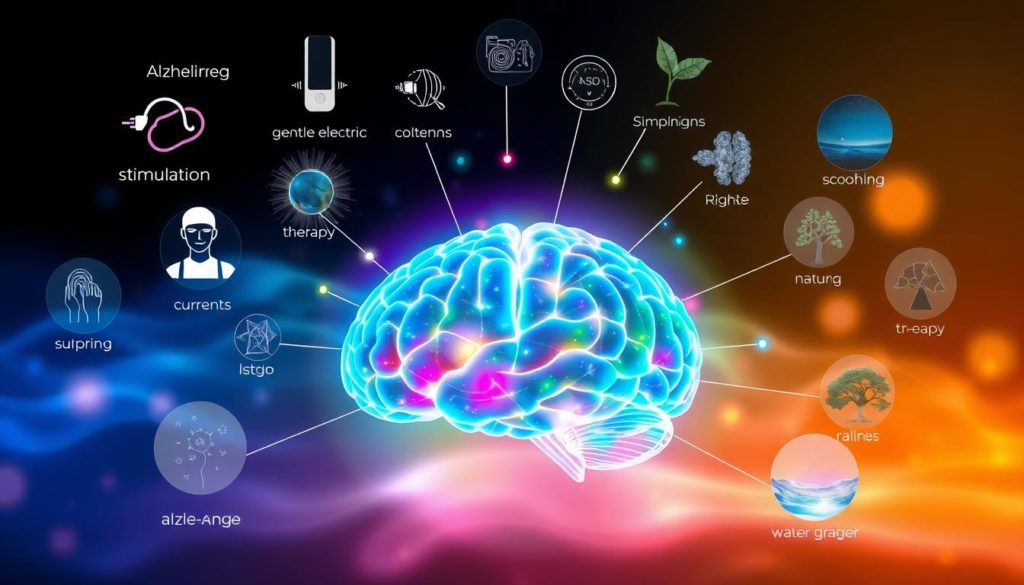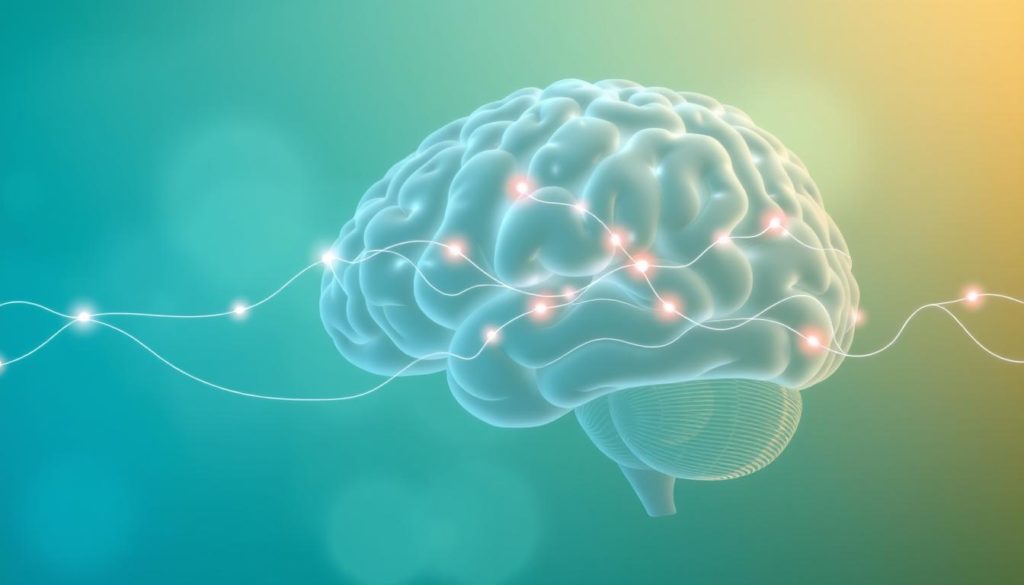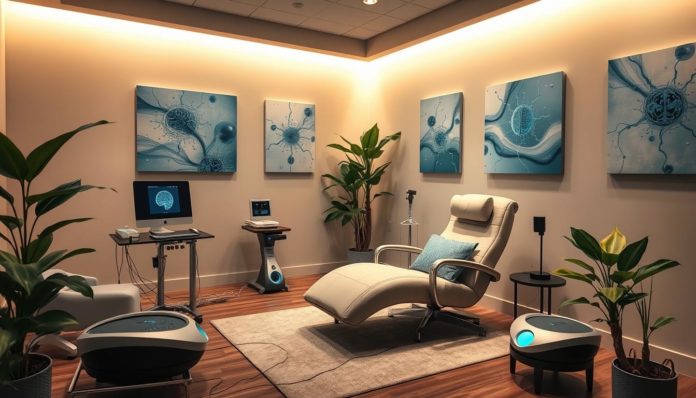Did you know over 6 million Americans have Alzheimer’s disease? This makes the search for effective treatments very important. Recent tech advances have brought new non-drug treatments that could change how we manage cognitive problems.
Temporal Interference (TI) brain stimulation is one such exciting method. This gentle approach has the potential to boost neuron activity in the brain area linked to memory. Led by Imperial College London, TI therapy offers a safe option compared to surgeries.
Exploring these new treatments opens up many possibilities. Could this be the start of a new chapter in Alzheimer’s care? Keep watching as we uncover the future of brain-stimulation therapies for Alzheimer’s.
Introduction to Brain-Stimulation Therapies
Brain-stimulation therapies are gaining ground as promising treatments for Alzheimer’s disease. Millions around the globe suffer from this condition, which leads to memory loss and trouble with problem-solving. These new treatments focus on enhancing brain function to reduce these issues.

Understanding Alzheimer’s Disease
Alzheimer’s disease mainly affects older adults, impairing their brain functions severly. It causes memory loss and problems with reasoning and judgment. While drugs were often used before, there’s a growing interest in non-drug methods to help with dementia.
Emergence of Brain-Stimulation Treatments
In recent years, new brain-stimulation treatments have started to emerge. Some of the key innovations include Temporal Interference (TI) and Transcranial Magnetic Stimulation (TMS). These use electrical impulses to improve brain activity. They offer hope in slowing down Alzheimer’s and enhancing life quality.
This progress highlights the need for ongoing research in this area. It aims to create a future where we can better manage cognitive decline.
Non-Invasive Temporal Interference (TI) Brain Stimulation
Temporal Interference (TI) is changing the game in fighting cognitive decline. It uses two high-speed electric fields. They meet and create a healing current. This method focuses on the hippocampus, a key memory area, without needing surgery.
Experts at Imperial College London and the École polytechnique fédérale de Lausanne have backed TI stimulation. It has many benefits, making it an interesting option for Alzheimer’s care.

How Temporal Interference (TI) Works
TI brain stimulation is done with two applicators outside the body. They send out rapid alternating currents. When they meet inside the brain, they form a slow-frequency current. This stimulates parts of the brain like the hippocampus.
This approach is a top advancement in Alzheimer’s therapy. It is a non-intrusive way to help with memory loss.
Advantages Over Traditional Methods
- Reduced Complications: TI avoids the need for surgical implants, cutting down on the risk of infections and other surgery issues.
- Cost-Effectiveness: TI costs less than many other invasive treatments. This makes it easier for more patients to get the help they need for memory loss.
- Broader Eligibility: Even those who can’t have surgery can use TI. It broadens the treatment options for Alzheimer’s.
| Traditional Methods | TI Brain Stimulation |
|---|---|
| Invasive Surgery Required | Non-Invasive |
| Higher Risk of Complications | Lower Risk of Complications |
| Limited to Eligible Patients | Broader Patient Eligibility |
| High Cost | Cost-Effective |
Transcranial Magnetic Stimulation (TMS) for Alzheimer’s
Transcranial Magnetic Stimulation (TMS) is a cutting-edge option among therapies for Alzheimer’s. It’s known for being non-invasive, effective, and having few side effects.
Overview of TMS
TMS is FDA-approved to treat depression and now it’s being tested for Alzheimer’s. It creates magnetic fields that stimulate the brain directly. This may help improve cognitive function.
How TMS Works
Magnetic pulses are sent through a coil to the head during TMS. These pulses can change neural activity in targeted brain parts. This process could enhance memory and improve thinking capabilities, showing TMS’s potential for Alzheimer’s patients.
Effectiveness of TMS in Alzheimer’s Patients
Studies show that high-frequency TMS may greatly help those with early dementia. When TMS is used with thinking exercises, its benefits increase. This combination offers new hope in the field of Brain-Stimulation Therapies for Alzheimer’s.
| Key Aspects | Description |
|---|---|
| Approval Status | FDA-approved for depression, experimental for Alzheimer’s |
| Mechanism | Magnetic fields stimulate targeted brain areas |
| Benefits | Memory enhancement, improved executive functions |
| Combination Therapy | More effective when paired with cognitive training |
Deep Brain Stimulation (DBS) Techniques
Deep Brain Stimulation (DBS) is a standout method for managing advanced Alzheimer’s. It involves placing electrodes in the brain. These are linked to a generator. This device sends electrical impulses to adjust brain activity.
What is Deep Brain Stimulation?
DBS was first used for Parkinson’s disease. It has now become key in exploring cognitive enhancement through DBS. By affecting the brain’s electrical activity, it aims to improve memory and decision-making in Alzheimer’s patients. Early studies have shown the deep brain stimulation benefits, marking its potential beyond common treatments.
How DBS is Administered
DBS surgery places electrodes in certain brain parts. These electrodes connect to a generator in the chest or belly. The generator’s electrical pulses aim to fix abnormal brain activity seen in Alzheimer’s. Because it’s invasive, only certain patients are good candidates. This careful choice helps maximize deep brain stimulation benefits while keeping risks low.
Effectiveness of DBS in Cognitive Decline
DBS shows promise in addressing Alzheimer’s cognitive issues. It works best early in the disease. Early detection and treatment are therefore crucial. While cognitive enhancement through DBS holds significant promise, it does come with surgery risks. Finding the right balance between advanced Alzheimer’s disease management methods and safety is vital in research.
The table below summarizes DBS in Alzheimer’s treatment:
| Aspect | Details |
|---|---|
| Procedure | Surgical implantation of electrodes and connection to a generator. |
| Benefits | Cognitive enhancement, improved memory and decision-making. |
| Effectiveness | Most effective in early-stage Alzheimer’s. |
| Risks | Includes post-surgery complications and patient selection challenges. |
Clinical Trials and Research on Brain-Stimulation Therapies
Research is key to improving brain-stimulation treatments. Institutions like Imperial College London lead this work, making big strides in Alzheimer’s research.
Recent Research Findings
Temporally Interference (TI) therapy has shown encouraging results in recent trials. It could help boost memory in Alzheimer’s patients. This matches the goals of new neurocognitive therapies, which aim to bolster cognitive health.
Ongoing Clinical Trials
Many clinical trials are now underway. They aim to fine-tune these therapies for dementia at all stages. These studies are trying to perfect how the therapy is done, look at the long-term outcomes, and see if cognitive abilities get better.
This push to improve and adapt treatments promises more effective solutions. It’s all about making these therapies work for more people in more ways.
Comparing Different Brain-Stimulation Therapies
It’s vital to understand the differences between brain-stimulation therapies for customized treatments. The brain-stimulation efficacy comparison helps find the best Alzheimer’s treatment options for each patient. Factors like success rates, patient risks, Alzheimer’s stage, and cognitive improvement potential are key.
Examining both non-invasive methods like Temporal Interference (TI) and Transcranial Magnetic Stimulation (TMS) and invasive options like Deep Brain Stimulation (DBS) is critical. Each technique comes with its own pros and cons that need careful evaluation:
| Therapy | Type | Efficacy | Risks |
|---|---|---|---|
| Temporal Interference (TI) | Non-Invasive | Moderate effectiveness in neuropsychological interventions for memory loss | Minimal |
| Transcranial Magnetic Stimulation (TMS) | Non-Invasive | High effectiveness | Moderate, with potential headache or scalp discomfort |
| Deep Brain Stimulation (DBS) | Invasive | High effectiveness in advanced stages | High, including surgical risks |
Future research will play a big role in creating personalized treatment plans for Alzheimer’s. Evaluating the efficacy of brain-stimulation will help pick the right Alzheimer’s treatments. For treatments focusing on memory loss to work, choosing the right brain-stimulation therapy is crucial.
Potential Risks and Side Effects of Brain-Stimulation Therapies
Brain-stimulation therapies offer new hope in Alzheimer’s treatment. But, it’s essential to know the potential risks. These innovative treatments come with precautions.
Short-term Side Effects
The short-term side effects depend on the therapy used. Transcranial Magnetic Stimulation side effects may include mild pain, headaches, or twitching facial muscles. These side effects are usually temporary but can bother some people.
With deep brain stimulation (DBS), risks can be higher. Patients might experience seizures or mood changes. Therefore, careful monitoring and thorough assessments are crucial to reduce these risks.
Long-term Complications
Long-term complications can also occur. Deep brain stimulation, for example, could lead to equipment malfunctions needing more surgery. There might also be effects we don’t know about yet because these treatments are quite new.
Managing these risks requires continuous care and evaluation. Still, for many, the advantages of DBS and similar treatments surpass the drawbacks. They offer hope to those facing cognitive decline, with important precautions.
Cost and Accessibility of Brain-Stimulation Treatments
The cost and how easy it is to get brain-stimulation treatments for Alzheimer’s matters a lot. Treatments like Deep Brain Stimulation (DBS) can be quite expensive. They often need surgery and special care afterwards. This option is promising but not widely available due to the need for skilled neurosurgeons and top-notch medical facilities.
Cost Considerations
When looking at cost for Alzheimer’s treatments, it’s important to compare different types. Transcranial Magnetic Stimulation (TMS) and Temporal Interference (TI) don’t need surgery and are usually cheaper than DBS. However, they can still be pricey, especially for long-term care. Insurance might cover some of the cost as they see the value in these treatments for dementia.
Availability in the United States
Getting non-invasive treatments is getting easier in the U.S. TMS and TI are found more in cities and in rural areas too. This makes it easier for more people to try these non-drug treatments. With technology getting better and more people recognizing their good points, the goal is to make these treatments affordable and widely available. This way, more patients can try these new treatment options.
FAQ
What are current non-pharmacological treatments for Alzheimer’s?
Today, we have treatments like Temporal Interference (TI), Transcranial Magnetic Stimulation (TMS), and Deep Brain Stimulation (DBS). They boost brain function without meds.
How does Temporal Interference (TI) brain stimulation work?
TI stimulates brain cells in the memory area with electric fields. It’s safe and doesn’t need surgery.
What are the advantages of TI over traditional methods?
TI is cheaper, safer, and more accessible. It’s great for enhancing memory without big risks.
What is Transcranial Magnetic Stimulation (TMS) and how does it work?
TMS, approved for depression, uses magnets to affect the brain. It targets areas linked to thinking and memory.
How effective is TMS in treating Alzheimer’s disease?
TMS can boost memory in early dementia. It works even better with cognitive training.
What is Deep Brain Stimulation (DBS) and how is it administered?
DBS requires surgery to put electrodes in the brain. These help improve brain activity in Alzheimer’s.
What has recent research on brain-stimulation therapies revealed?
Research from Imperial College London shows TI can help with memory. Scientists are working on making it better for dementia.
How can patients choose between different brain-stimulation therapies?
Choosing between TI, TMS, and DBS depends on many factors. A specialist can help find the right fit.
What are the potential risks and side effects associated with brain-stimulation therapies?
You might feel discomfort or risk seizures. Long-term, there could be device issues. Safety is key, so monitoring is critical.
How much do brain-stimulation treatments cost and are they accessible?
Costs vary. Invasive options like DBS are pricier and harder to find. Treatments like TMS and TI aim to be cheaper and more widespread.


